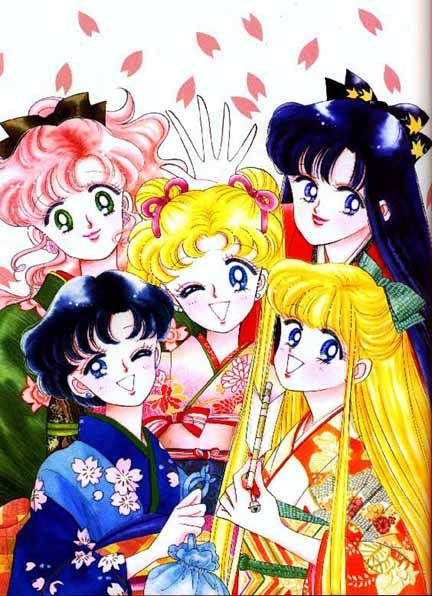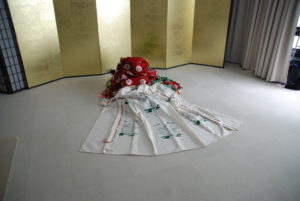Japanese Fashion
now browsing by tag
Kimono Patterns – Asanoha 麻の葉

Asanoha is one of my favorite kimono patterns. Especially when I see it done in Sashiko 刺し子 (Japanese embroidery) with a crisp white silk thread against an indigo background. Although it is equally beautiful as a subtle under pattern to a yuzen 友禅染 (resist paste dyeing technique) design.
Let’s take a look at this kimono pattern…

The Pattern of Asanoha 麻の葉 represents hemp leaves. It’s a pattern that has been used to decorate Buddhist statues since the Heian period 平安時代 (794 – 1185) .
“Asa” means hemp and “ha” means leaf. The design has 6 diamonds radiating from a center point (Although most hemp leaves have 5-7 leaves). Hemp was a very important plant in Japan as it was the primary fiber used in clothing along with silk until cotton was cultivated in the Sengoku period 戦国時代 (1467 to 1615). Most original yukata 浴衣 (summer kimono) and underclothing were made of hemp or silk.

Hemp grows quickly, does not need much care and is durable so it is often used in young children and baby clothes in the hope that they will grow strong and healthy
This design was particularly popular during the Edo period 江戸時代 (1603-1868), when it was promoted by Iwai Hanshirou 岩井半四郎 (1776-1847)

Sailor Moon 28th Anniversary

March 7th marked the 28th anniversary of Sailor Moon’s debut on Asahi Television. It aired at 7pm on Saturday nights
In honor of the anniversary here are a few pics of Sailor Moon and scouts in kimono!




Wearing a Juni-Hitoe Kimono (12 layer kimono) in Kyoto

The evolution of the kimono from those long ago designs borrowed from T’ang Dynasty to the modern kimono has been a long and winding path. It continues to meander on even today with new fabrics, new lengths and new decorations such as lace and pockets.
One marker along the way, and a marker that continues to stand out and shine across the ages, is the Juni-Hitoe Kimono – 十二単 – (Juni = 12, Hitoe = an unlined kimono). Perhaps it is the abundance of beautiful art that portrays the courtesans of the day in these sumptuous robes. Perhaps it is the serene beauty of the Hina Matsuri doll displays where the Emperor and the Empress yearly rule over their court. Perhaps it is the echoes of the Lady Murasaki’s timeless Tales of Genji, written when this sort of attire was the everyday dress of the elite.
I once read that a lady of the Heian era was more likely to be criticized for her lack of taste in the colors and patterns of her kimono than her possible numerous love affairs.
When I told her I was going to try one on my kimono instructor told me that that was her next level of training – the Juni-Hitoe. There aren’t many places, even in Japan, where you can get an authentic experience of wearing one of these elaborate ensembles. One of them is the Nishijin Textile Center of Kyoto.
The ladies there, who spoke very little English, were surprised to find out that I was a kimono kitsuke student and seemed very pleased that I could name the different pieces as I was dressed. The hadajuban did not seem to concern them at all except to make sure that it was crossed left over right and that the back was pulled far enough down to not be exposed at the collars of the coming kimono. Other than that it was left very loosely tied on. Which was a surprise to me as my instructor is very particular about how I tie even my hadajuban. Then came padding around my shoulders, chest and waist, a Juban and the Kosode – which truth be told has closer ties to the modern kimono than the Juni-hitoe.
After that they dressed me in what seemed unreasonably long pants similar to hakama called Nagabakama. I couldn’t figure out how a woman would be expected to hold them up under the kimono layers and was very surprised to find that they were folded under my feet to trail behind me. So in essence you are stepping on the pants as you walk. Which would definitely restrict you to a slow shuffle while wearing them!
Then came layer after layer of kimono, one color after the other. The woman folded the long sleeves into an almost triangular shape, had me hold my hand flat and stiff and then through the arms of all the other layers she would slip everything and then let it drop. She obviously knew exactly what she was doing and it took her less time to dress me in the many layers of that kimono than it takes me to dress myself in a modern one!
Besides the pants, another thing took me off guard. The entire ensemble is held together with one tie. A single tie as simple as a long koshihimo!!
As each layer was put on she would tie it. Then the next layer would go on and she would tie that one and then reach under and untie the last layer. When we were done the whole thing dropped off in a single fluid motion right back down to the pants and kosode!
I think everyone interested in Kimono should try to wear one at least once! There is a majesty to this outfit that is not to be found in a kimono of today. In the very physical weight of the robes you can feel the power across the centuries of those noble ladies, but also the sorrow and the weight on their shoulders. To experience it will truly make you think of them in their wood and lacquered castles, hidden behind shoji doors and screens. The restricted ability to walk. All of those layers in a Japanese summer long before the comfort of air conditioning. It makes the modern kimono feel light, airy and mobile by comparison!
If you are interested in wearing a Juni-Hitoe the next time you are in Kyoto you will find all the information that you need at the Nishijin Textile Centere’s official website. A reservation is required, it takes slightly more than an hour, and it costs about $130 USD. With that you will receive one professional photo. (Don’t be afraid to ask if they will take some photos with your cellphone.)












 D5 Creation
D5 Creation